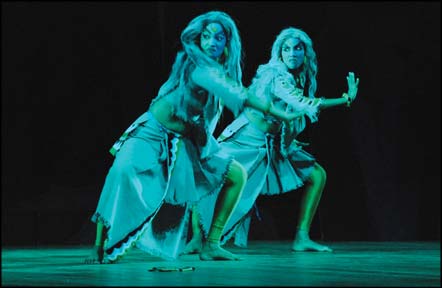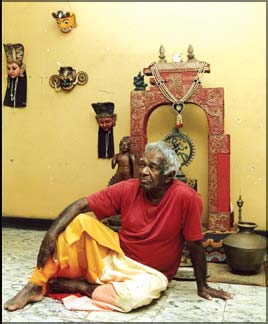Arts
Sri Lankan ballet and its future
National Ballet Day falls on January 26:
By Indeewara Thilakarathne and Ranga Chandrarathne
Though dramas and stage plays are more or less confined to Colombo
and Kandy, to a lesser extent, rarely a ballet is staged even in
Colombo. It would not be surprising even if one were to question whether
ballet really exists in Sri Lanka. The national Ballet Day was fittingly
declared on the birthday of legendary dancer and theatre personality
Chitrasena. Chitrasena was born on January 26, 1921.
 Although the Sri Lankan audience was used to watch dance drama, it
was not familiar with ballet in its original form. Some watch ballet for
its elegant costumes, attractive ballet dancers and their beautiful body
movements. The dialogue the ballet intended to maintain with the
audience is not the kind of superficial attraction some identified with
the ballet. Although the Sri Lankan audience was used to watch dance drama, it
was not familiar with ballet in its original form. Some watch ballet for
its elegant costumes, attractive ballet dancers and their beautiful body
movements. The dialogue the ballet intended to maintain with the
audience is not the kind of superficial attraction some identified with
the ballet.
Primarily, ballet creates zest in the audience by musical scores and
body movements although ballet is termed as dramatic manifestation. In
fact, ballet conveys its message through music, elegant animation and
stage craft. Basically it narrates a story.
Shown John Nervier and John Wiver, the pioneers of the modern ballet
attempted to narrate a story through ballet in Royal Court. Subsequently
this ballet (Ballet de action) evolved into a dramatic manifestation.
Contemporary ballet whether in Asia or in Europe, does not only
narrate a story, but explores religious and philosophical ideas.
By now diverse forms of ballet such as plotless ballets (ballet only
with music) have been developed. Originally ballet was developed in the
West to depict Western myths and fairy tales with simple plots. Over
time, it has evolved into a complex mode of dramatic expression
assimilating diverse traditions of art. Thematically it has developed as
simple drama plot of fairy tales to Shakespearean tragedies on violence,
war and feminism. Many traditions of music such as Asian, African and
Jazz enriched ballet repertoire of music and complex grammar of
choreography.
The rudimentary form of ballet being staged in Sri Lanka was by the
'Group Modern', travelling troupe which came to Sri Lanka in 1935. A
prominent member of the troupe was Rabindranath Tagore. The Sri Lankan
performance was so successful that some of the inspired youth
subsequently went to India to learn the craft.
From 1940's on, ballet in Sri Lanka had been developing parallel to
the development of dance drama in India. Inspired by Indian dance drama
on Sri Lankan ballet. Premakumara Epitawala's Sela Lihini Sandeshaya
although it was more a musical than a ballet was of a different style.
Sri Lankan ballet carved out its distinctive indigenous flavour and
physique with Chitrasen'a production of `Karadiya' in 1961 and `Nala
Damayanthi' together with 'Karadiya' manifested a novel form with blend
of indigenous, Indian and Western traditions. Chitrasena's subsequent
productions such as Kinkini Kolama was (based on low country dancing)
and "Shiva Ranga" born out of research into folk traditions such as
Kolam.
In 'Shiva Ranga', though the story is based on an Indian legend,
modern Western and Indian abstract ballet styles have been used instead
of Indian dance drama style. Premakumara Epitawala, Shesha Palihakkara
and Basil Mihiripenna have substantially contributed toward realising an
indigenous tradition of ballet.
Ravibandu Vidyapathy's rendering of Shakespeare's Macbeth into a
ballet was one of the important productions of ballet in contemporary
Sri Lankan theatre. It is a full length ballet produced in Sri Lanka
after a long time.
Perhaps, the selection of Macbeth itself is a daring act especially
given the unprecedented success the play enjoyed over the centuries
since its original production by Shakespeare himself. Macbeth is one of
the few plays which have been translated into diverse media including
into film. The grotesque details that are dramatically depicted in the
film version or acted on the stage, unfortunately, cannot be adapted
into a ballet , in their entirety, as the dramatic personae confront
with inherent constrains in the medium of ballet.
The principle constraint in a ballet compared to conventional play or
film, is that conversation and dialogue are not possible in a ballet. So
the roles of conversation and striking dialogues have to be depicted in
terms of carefully crafted pieces of choreography together with
painstakingly practiced facial expressions. The emotional scores and
dramatic situation are signalled by changing tempo of music score that
should be heartbeat of a ballet.
Costume design also plays a vital role in a ballet as the costumes
not merely introduce different dramatic persona but their distinct
characteristics.
However, the drowning effect of music in the scene where Lady Macbeth
knocks on the door was a marked shortcoming. It is hoped that this major
lapse be corrected in the future production of the ballet. The knocking
scene constitutes important developments in the plot.
Samanthi Vidyapathy has shown remarkable talents in portraying the
seminal role of Lady Macbeth. Her facial expressions and even eye
contacts were fine-tuned to suit the changing moods of the character. It
should be mentioned here that her present portrayal is far an
improvement compared to the Hecuba in Nirmana and may caused by slightly
slimed figure. Her dramatic face dominated throughout the ballet.
Ravibandu's rendering of Macbeth into an oriental ballet should be
judged against this technical backdrop and it should be unjust to
consider it as complete adaptation of Macbeth into an oriental ballet.
On one hand, Macbeth the oriental ballet depicts only a selected act
of the original play suitable to the medium and out of which an
aesthetically satisfying pieces of choreographs can be made.
For instance, character which plays a prominent role in the original
play, here plays a study material for post-graduate studies.
The legend lives on
The 88th birth anniversary of Chithrasena:
Colossus in the field of dancing and theatre Chithrasena re-defined
dying traditions of indigenous dancing which were confined to rituals
and adapted them to modern theatre with their multitude of
embellishments. More than anything else, it was his life-long commitment
to the craft and the monumental works resulted from sheer dedication and
hard work that remain as a rich repertoire. It is this tradition that `Chithrasena
Kalayathanaya' continues to nurture with research and innovation being
added to its creations.
As the nation commemorates the 88th birth anniversary of Chithrasena,
the legendary dancer and theatre personality, it is pertinent to look
back on the thorny track the legendary dancer trod on and the path he
paved for posterity to walk along in search of excellence and innovation
in the craft.
 January 26, the day Chithrasena was born has been declared the
National Ballet Day as a mark of respect to the legend. January 26, the day Chithrasena was born has been declared the
National Ballet Day as a mark of respect to the legend.
Adornment
Chitrasena laid the firm foundation for dancing admixing new features
with embellishment appropriate to it, making it suitable even for an
international audience. His stage personality became a role model for
aspiring dancers. He created theatrical marvels in his monumental work,
ballet Karadiya. For instance, the dream scene in Karadiya is a fine
example of creating theatrical marvels which are inherently linked to
the work. Most of the scenes in ballets Nala Damayanthi and Shivaranga
remind of mystic quality in Asian myths. On the other hand, Kinkini
Kolama manifests visual features of old Sri Lankan folk theatre.It
should be mentioned here that `Kinkini Kolama' which was especially
choreographed for Upeka, Chithrasena.
The essence of dancing, irrespective of diverse traditions, lies in
its ability to entertain the dancer through rhythmic movements of the
body and to convey it to the audience as an expression of emotions. It
is in this light that we should appreciate Chithrasena and his
trailblazing career in dancing.
Chithrasena's practice would strike a delicate balance between two
extremes of totally being materialistic and being spiritual, completely
forgetting the existence of the body. His repertoire of works will
remain as masterpieces of lasting value which will inspire generations
to come.
One of the significant features of Chithrasena's practices was that
his consideration of dancing not as a mere form of art which manifests
`Sri Lankan culture' but an art capable of expressing one's inner-most
soul. He emphasised this fact in performances such as Nurthanjali and
Navanjali which were adapted to traditional theatre.Through his
larger-than-life personality, Chithrasena has left indelible footprints
on the arena of Sri Lankan dancing. Perhaps, he will be remembered by
the posterity as a peerless pioneer who uplifted Sri Lankan tradition of
dancing from its status of being a ritual to a fully-fledged art form
suitable for proscenium stage. He not only introduced ballet to Sri
Lankan theatre but also the pioneering choreographer in Sri Lankan
dancing.
Golden era
With his death a golden era in Sri Lankan dance in which the first
ever Sri Lankan ballets such as Karadiya and Nala Damayanthi were made,
came to an end against the back drop of deteriorating standards in
almost all forms of arts and even in Sinhalese literature.
One of the predominant characteristics of the post-Chithrasena era
was drastic cultural alienation and all-encompassing commercialism with
popular culture centred on cheap movies from Hollywood and Bollywood.
The degeneration which commenced in the system of education soon,
extended into other spheres such as arts, culture, language and
literature and social values that had been held sacred once, gave way
for borrowed values based on ideologies like post-modernism.
Traditional dance has been so commercialised that it reduced to
ornamental arts and became part and parcel of local weddings or opening
ceremonies . Although commercialism is to be blamed for the situation,
other factors such as decreasing audience for serious arts and absence
of appreciation of classical works of art have also been adversely
contributed to the present crisis in dancing.
-IT and RC
Nature in splendour
by Ananth PALAKIDNAR
Ronali Abeywickrema's photographic exhibition on waterfalls titled
`Nature in Splendour' was held at Lionel Wendt, recently.
Ronali who is a lawyer by profession from Badulla displayed 75
pictures of waterfalls taken by her in various locations in the hill
country.She developed the interest in taking pictures of water falls
when she was travelling in trains as a kid between Badulla and Colombo
with her parents.
Ronali's father first taught her how to handle a camera and her
mother made her to admire the beauty of the waterfalls whenever they
travelled in the train.
Ronali's search for waterfalls was tedious. However, she was
determined to go in search of waterfalls deep into the mountainous
terrains and take pictures.
Nature in Splendour the photographic exhibition of waterfalls by
Ronali, was not only a treat for photographic enthusiasts. But also a
food for thought in preserving the nature.
Tunes of Hues
Tunes of Hues, an exhibition of visual paintings by Upachandra
Tilakawardana will commence at Lionel Wendt Art Gallery on January 30 at
6.30 p.m.
The exhibition will be remain open until February 1 from 10.00 a.m.
to 8.00 p.m.
Tunes of Hues is Upachandra's second exhibition. He is also the music
director of ten popular teledramas such as `Degamdora Mayawa', `Maya', `Agni',
`Swarna Veena', `Mini Palanga', `Chandra Vinsathi' and `Sidangana'. |

